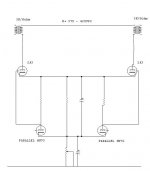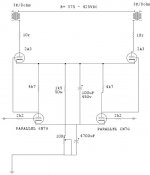Um no, not really. I don't know how you expect to get anywhere near full swing from the driver.
Also, I don't know if you intended this to be balanced (PP), if not it'll have a lot of cross-talk at low frequencies, unless you regulate the cathode voltages.
What's the 2A3 plate resistors for?
Oh, and 12AU7 works a bit better than 6N7, though I suppose you have one or two on hand to use up.
Tim
Also, I don't know if you intended this to be balanced (PP), if not it'll have a lot of cross-talk at low frequencies, unless you regulate the cathode voltages.
What's the 2A3 plate resistors for?
Oh, and 12AU7 works a bit better than 6N7, though I suppose you have one or two on hand to use up.
Tim
I'm not clear about what you're trying to achieve. Series amplifiers aren't generally a good idea in power stages. Is it PP?
The single 100ohm pot regulates the cathode voltages:1.5 on the 6n7 cathodes,150v on the 2A3 cathodes.2A3'a have 275v across them,Try it and see.
Is the diagram missing a connection to the 6SN7G cathodes? There doesn't appear to be a DC path to ground for the input tube cathodes.
I think his schematic program neglects junction dots. Looks to me all the current flows through the 100 ohm rheostat.
So just how much power is this capable of, and how much is the 2A3 actually capable of at its operating point? The driver (especially with 4.7k? yeesh) will murder your output.
Tim
So just how much power is this capable of, and how much is the 2A3 actually capable of at its operating point? The driver (especially with 4.7k? yeesh) will murder your output.
Tim
- Status
- Not open for further replies.
- Home
- Amplifiers
- Tubes / Valves
- Definitely NOT a Loftin-White!!

